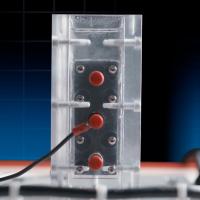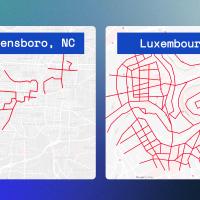Electric planes could soon transform aviation, an industry that connects the global community at steep costs.
The aviation industry accounts for 2% of human-induced carbon dioxide emissions (CO2) worldwide and 12% of transportation-related CO2 emissions in the U.S. The more than 38 million flights people take each year damage our environment in multiple ways.
Beyond carbon emissions, flying helps create the greenhouse gas tropospheric ozone, which contributes to global warming. Jet engines produce contrail cirrus clouds that trap heat radiating from Earth’s surface, release particulate matter into the stratosphere that damages the ozone layer, and pollute air near airports. Altogether, emissions from commercial aircraft are projected to triple by 2050 if left unchecked.
What’s the solution? For Roei Ganzarski, CEO of the electric aircraft motor company MagniX, the answer isn’t to shame or shut down the industry, but to fundamentally change the nature of commercial flying through zero-emission technologies, cheaper costs, and easier access to regional flights.
“We are building a world where flying in [electric] planes is no different from getting on a bus, or a subway.”
Roei Ganzarski
It’s an alluring vision. But given the long history of electric aircraft, what’s taking the sector so long to take off?
Innovating electric planes
The first experiment in electric air travel dates back to 1883 when French aviator piloted the first electrically powered airship. Although successful, the test flight highlighted the main obstacle for every subsequent foray into electrical flight: energy storage.
Flying takes a ton of energy. Powering aircraft with electricity requires storing that energy in batteries. Heavy batteries. More weight on the aircraft means you need more energy for flight. It’s a vicious circle. To put in perspective: Powering a 737-size jet with current battery technology would require a battery the size of the aircraft itself.
“Energy storage in general is today the challenge that aviation needs to solve to make this mainstream,” Ganzarski told Freethink.
Adding to the weight problem is the fact that electric motors often overheat, which means electric planes need heavy cooling systems. MagniX created a workaround: “We developed our own proprietary internal cooling system that allows us to maintain the light weight but still maintain the temperature,” Ganzarski told Freethink.
MagniX put its cooling system in the air last year when it retrofitted a Cessna Caravan with a 750-horsepower electric engine and conducted a successful test flight, making history as the largest aircraft to fly solely on electricity. Still, it was a short flight: The retrofitted Cessna had a range of only about 100 miles. A jet-fueled Cessna can fly about 1,000 miles.
Even with modern batteries and cooling systems, conventional aircraft motors remain far more efficient than electric motors. The key metric is energy density: the amount of energy stored in a given system or space. Jet fuel is more than 12 times more efficient than the best modern batteries in terms of energy density.
But electric planes don’t need to serve the same functions as big commercial airliners. Most flights across the U.S. are rather short: 70% fly fewer than 1,000 miles. That’s why Ganzarski thinks the key to launching electric planes into the mainstream is competing for regional flights, like New York City to Washington, D.C. or San Francisco to Los Angeles.
“Why try to solve for a problem that’s the minority of flights?” Ganzarski told Freethink. “Let’s try to first of all solve the majority of flights — in this case, take a 40-passenger plane and go fly [500 to 800] miles. That’s where we are right now with [energy storage] and we can do that with today’s batteries and fuel cells.”
Economic incentives might spur the first phase of that transition. From an industry perspective, the most appealing incentive is likely fuel savings: A 90-minute flight in a Cessna Caravan costs about $420 in fuel, while the same flight in MagniX’s retrofitted aircraft costs about $25. There’s also maintenance savings: Electric motors are significantly easier to maintain, mainly because they’re designed more simply and don’t have to circulate fuel.
But building a world where taking electric plane flights is similar to boarding a bus or train requires more than technology.
Rethinking aviation infrastructure
The U.S. is home to more than 10,000 airports, of which commercial airlines use only about 600. Because it often takes a long time to access and get through those major airports, they wouldn’t be ideal hubs for electric planes offering regional flights; who wants to shuffle through an airport for two hours for a 45-minute flight?
Smaller airports represent a better opportunity for electric aviation. Equipping the thousands of private and public-use airports across the U.S. with the ability to accommodate electric planes would open up more opportunities for cheap air travel, while also cutting down on emissions from car trips to airports. Another upside: The relative quietness of electric planes likely wouldn’t bother nearby residents as conventional aircraft do.
“If we’re successful, we will make it so accessible and so affordable that going to see the rest of the country will be a normal course of action,” Ganzarski told Freethink.
“We will have truly changed the face of transportation — the way people commute, the way people connect.”
When might we see that future? It’s hard to say, but government agencies and the private sector have recently been ramping up investments into the development and use of electric plane technologies. NASA announced this year it was seeking proposals for Electrified Aircraft Propulsion (EAP) technologies, which promise to curb environmental destruction and benefit “both the public and the airline operators.” The agency aims to help introduce electric technologies to global flights by 2035.
In the private sector, MagniX is collaborating with other electric-plane companies to retrofit conventional aircraft with electric engines — an approach that involves far fewer regulatory hurdles than experimenting with new electric planes. United Airlines recently agreed to purchase 100 19-seat electric planes from the Swedish company Heart Aerospace, scheduled to enter service in 2026. Meanwhile, the logistics giant DHL also plans to add 12 electric cargo planes to its fleet.
But don’t expect to board an electric plane anytime soon. The Federal Aviation Administration hasn’t yet approved passenger flights on electric planes, and it’s unclear when the agency might do so. Electric planes first need to prove the technology is safe. It’s probably a worthwhile delay. After all, planes might use different fuel sources, but all plummet to the same place if they malfunction in the sky.


